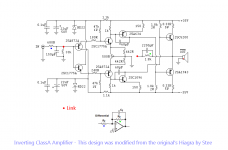Jean Hiraga's Super Class-A Amplifier
This design was modified from the original's Hiagra
to obtain an inverting input
and eliminate the internal function of the differential feedback
that works much better with the external resistive divider
This design was modified from the original's Hiagra
to obtain an inverting input
and eliminate the internal function of the differential feedback
that works much better with the external resistive divider

Attachments
Last edited:
An inverting amplifier such yours can be done with any kind of amplifier: a simple TDA2006 can be used. The class A output is a good refinement, I remember old auto radios with a germanium AD149 transformer loaded.
The input impedance of 680 ohms is not something I'd expect to be driven easily with any kind of preamp. Increasing resistor values would increase noise, too.
Guess why high-gain inverting amps aren't too popular.
You may find them as inverting buffer stages (gain -1) though.
Guess why high-gain inverting amps aren't too popular.
You may find them as inverting buffer stages (gain -1) though.
Ohh that shorr integral current feedback of the hiraga is the best part of it...why would you take that out,,,??
because pull up the emitter to make the NFB difference generates emphasis
the difference must be made by two resistors
680 ohm input impedance are great for any CD player
the difference must be made by two resistors
680 ohm input impedance are great for any CD player
Have you tried this amplifier? You have positive feedback (it's an oscillator) and the output devices will run at any current they would like...
Have you tried this amplifier? You have positive feedback (it's an oscillator) and the output devices will run at any current they would like...
You are right. I didn´t see that There are 2 voltage inverters (CE) and 2 followers (CC). This is a zero net inverting phase, so it is positive feedback.
I would say any few kind of preamp like such equipped with tubes and several vintage models from the 60s (e. g. first solid state generation).The input impedance of 680 ohms is not something I'd expect to be driven easily with any kind of preamp.
Considering the advantages and disadvantages of a lower input resistance by power amps for new projects (approximately between 500 ohms and 5000 ohms), clearly outweigh the benefits.
Modern audio devices with high output impedance are very rarely on the marked.
Additional a refitting of an impedance matching section isn't a great issue.
Jean Hiraga's Super Class-A Amplifier
This design was modified from the original's Hiagra
to obtain an inverting input
and eliminate the internal function of the differential feedback
that works much better with the external resistive divider
Check also out the schema from post #4 about
http://www.diyaudio.com/forums/soli...ody-burmester-avm-schematics.html#post2598494
Same basic consideration regarded the input stage
Last edited:
- Status
- Not open for further replies.
- Home
- Amplifiers
- Solid State
- an inverting amplifier
